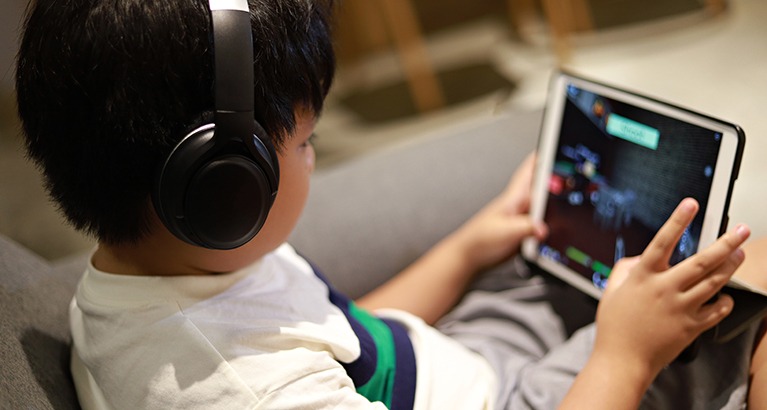
Parents around the world struggle with how to limit or otherwise regulate the digital media exposure of their children, and the topic has been the subject of recent hearings at the US Congress and other legislative bodies.
But what is the connection between digital media exposure and the cognitive functioning of young people?
Research co-authored by Professor Lucia Reisch of Cambridge Judge Business School involving thousands of children and adolescents in 9 European countries takes a broad look at this topic, including the connection between cognitive functioning and exposure to multiple sources of media through digital multitasking (such as checking emails while watching videos).
Children need protection against likely harms of digital environment
The research finds that extensive smartphone and/or Internet exposure combined with low exposure to computers (for entertainment and education) and medium television exposure was associated with higher impulsivity and cognitive inflexibility scores – especially in girls.
“Children require protection against the likely adverse impact of digital environment,” concludes the research published in Scientific Reports, part of the Nature portfolio of journals. “Exposure to smartphones and media multitasking were positively associated with impulsivity and cognitive inflexibility while being inversely associated with decision-making ability.”
Lucia, Director of the El-Erian Institute of Behavioural Economics & Policy at Cambridge Judge, has done extensive research related to digital issues, including studies on the links between healthy food labels and diet and ways to encourage people to use healthier forms of transport.
Children require protection against the likely adverse impact of digital environment.
Study highlights extensive impact of digital media on child development
“We thought it was important to take a close examination of how smartphone and other digital media use by young people affects so many aspects of their development – including decision-making ability, flexibility, concentration, dietary habits and socialising,” says Lucia.
“Given the ubiquitous use of smartphones by young people, we think this research is an important step in better understanding how digital media affects childhood and adolescent cognitive ability.
“But there is still plenty more research to be conducted in this area, which will be welcomed by parents, academics and others around the world,” says Lucia, who is also the co-author of a blueprint for the European Union on how digital technology policies can improve the sustainability of many sectors and promote social equity.
Given the ubiquitous use of smartphones by young people, we think this research is an important step in better understanding how digital media affects childhood and adolescent cognitive ability.
El Erian Institute research examines link between digital exposure and obesity
The El-Erian Institute has done extensive research on the relationship between behaviour and health, including obesity; there has also been other research showing that digital media exposure is linked to unhealthy dietary habits among young people and obesity in adults.
“This is the first observational study to investigate the role of digital media exposure on several measures of cognition in European children and adolescents,” says the research on digital media use by Lucia and her colleagues. “In contrast to most other studies focusing only on TV and video-gaming, we examined various digital media exposures including contemporary digital media like smartphone and internet, as well as media multitasking.”
Children growing up in a saturated digital environment
The research cites a saturated digital environment for young people, with children and adolescents in the US using digital media for entertainment for and 8 hours daily, respectively, while European children aged 9-16 use online media for nearly three hours per day.
“Governments should ensure legal guardrails for safe and beneficial use of digital media,” says Lucia. “This is not about blocking kids from access per se, but about making it a children-safe environment. This may include very different things, including limits on hours of use of digital media within schools and limiting potentially damaging content.
“Platforms such as those owned by Meta (including Facebook and Instagram) where children and teens spend most of their time have a huge responsibility to curate the platforms to minimise the potential dangers. Examples include age certification and filters, monitoring and feedback on social media hours, and soft defaults limiting social media hours (by parents or teens themselves as a kind of self-nudge), and limiting or banning picture filters that seem particularly impactful on girls regarding body image.”
This is not about blocking kids from access per se, but about making it a children-safe environment.
A comprehensive study of children 8+ across Europe
The research is based on a deep dive into data from the I.Family study in 2013-2014 conducted across nine European countries: Belgium, Estonia, Cyprus, Hungary, Italy, Germany, Poland, Spain and Sweden. The research included children age 8 and older who provided information on emotion-driven impulsiveness, decision-making ability, and cognitive inflexibility, in accordance with ethical standards of the Helsinki Declaration of 1975 and later amendments.
“Access to such extensive cohort data is rare, so the information is really useful to researchers even though it dates back a decade. It’s likely that there is more digital media use today with different quality”, says Lucia.
For emotion-driven impulsiveness, the research is based on the replies of 3,400 children based on a score ranging from 12 to 48 (a higher score indicating higher impulsivity), with a final sample of 3,261 children after some were excluded based on eligibility criteria.
The cognitive-inflexibility findings were based on 4,034 children and adolescents (the final sample numbered 3,441) who performed a version of the Berg Card Sorting tests in which cards of different colours and shapes are shown to participants who are asked to sort cards based on a particular rule (such as colour, symbol or number).
Decision-making ability was measured on 4,169 children (final sample of 4,046) using a version of the Hungry Donkey Test in which participants help a hungry donkey collect apples by choosing one of four doors – with Doors 3 and 4 representing better long-term choices based on net gains.
Other data collected include children’s age, sex and country of residence, parental education attainment, media rules at home, family structure (i.e., only child versus siblings, one-parent family vs both parents), weight status, pubertal status, total daily sleep duration and psychosocial well-being.
Digital media duration and media multitasking in children
Researchers also asked about digital media use duration and media multitasking. Children were asked to report digital media use separately for weekdays and weekends, for example: “Thinking about yesterday, about how much time did you spend watching TV shows, movies or music videos on a cell phone?”
According to the study, more than half of participants (57%) had low usage of all digital media types – less than one hour for each media type. About 13% of children had high digital media use except smartphone (more than two hours a day), while 10% had high smartphone and Internet use, but medium TV and low PC use. Around 20% children reported medium TV/internet use (between 1-2 hours a day), but low smartphone/PC use.
“Positive association between media multitasking and impulsivity and cognitive inflexibility were also observed. Although not statistically significant, smartphone exposure and media multitasking were inversely associated with decision-making ability , while PC and internet exposure were positively associated with decision-making ability.”
5 key findings from the study
1
More digital exposure means higher impact
The duration of exposure to digital media in children is positively associated with emotionally driven impulsiveness and cognitive inflexibility, independent of a child’s well-being, weight status or sleep duration. “One additional hour of smartphone and internet exposure daily were associated with higher impulsivity score,” the study says..
2
There is a difference between internet-based and non-internet-based media
The longer children used smartphones or other digital media the higher impulsivity score they received, “while no association was observed for non-internet-based media including TV and PC.” The authors suggest that “perpetual flow of information and input received simultaneously from the online environment such as emails, notifications and social media posts, may act as stressors”. This in turn could lead to “mindless eating in front of screens especially in reward-seeking contexts”, and this may also reflect that digital media for children and adolescents displaces real-life interactions between parent and child as well as sibling and peer relationships.
“Social interactions are crucial for a healthy development because they built the foundation of processes related with personality and cognitive development, such as emotion regulation,” the research says. “The interference of digital media with parent–child interactions may compete with children’s ability to concentrate and regulate their emotions, leading to internalising and externalising problems like reduced ability to control impulses.”
3
High smartphone and internet use elicits different results for boys and girls
“The association between “high use of smartphone/internet use, medium TV/low PC” and impulsivity was stronger among girls compared to boys. This could be because girls mainly use smartphone/internet for socialising and social media, while boys mainly play games, the researchers say.
“Previous evidence shows that social media exposure impacts girls’ and adolescents’ psycho-emotional well-being and body-image via social comparisons over images posted on these platforms,” the research says. “This may lead to emotional overeating or restrained eating” owing to coping strategies for relieving negative emotions.
4
Impact can lead to poorer academic performance
Smartphone exposure and multimedia tasking were associated with higher cognitive inflexibility, which “may adversely impact youth’s ability to shift between tasks” – and this may lead to poorer academic performance in youths, say Lucia and her colleagues.
“Additionally, repeated exposure to fast-paced content, like short-edited video segments in social media (such as Instagram reels) or online game applications might trigger individuals into seeking higher arousal levels, which in turn hamper engagement in activities that require sustained attention (for example homework).”
5
Need for further research in this are
The research makes clear that it does not distinguish between the use of smartphones and Internet use for entertainment and educational purposes, and its examination of smartphone duration includes use for various content including music videos and TV shows – so the researchers urge further studies that might delve deeper into the particular use involved.
The study entitled “Digital media exposure and cognitive functioning in European children and adolescents of the I.Family study” is co-authored by Elida Sina, Christoph Buck, Wolfgang Ahrens, Juul M. J. Coumans, Gabriele Eiben, Annarita Formisano, Lauren Lissner, Artur Mazur, Nathalie Michels, Denes Molnar, Luis A. Moreno, Valeria Pala, Hermann Pohlabeln, Lucia Reisch, Michael Tornaritis, Toomas Veidebaum, Antje Hebestreit, and researchers associated with the I. Family consortium.
Featured research
Sina, E., Buck, C., Ahrens, W., Coumans, J., Eiben, G., Formisano, A., Lissner, L., Mazur, A., Michels, N., Molner, D., Moreno, L., Hermann, P., Reisch, L., Tornaritis, M., Veidebaum, T., Hebestreit, A. and l.Family consortium. (2023) “Digital media exposure and cognitive functioning in European children and adolescents of the I.Family study” Scientific Reports





